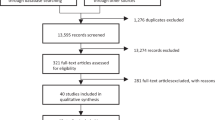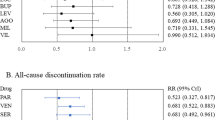Abstract
The possibility that antidepressant drugs, while effectively treating depression in the short term, may worsen its course through a sensitisation process has been proposed. Although this hypothesis has not been extensively tested, a number of clinical findings point toward this possibility: the very unfavourable long term outcome of major depression when treated by pharmacological means; paradoxical (depression-inducing) effects of antidepressant drugs in some patients with mood and anxiety disturbances; antidepressant-induced switching and cycle acceleration in bipolar disorder; the occurrence of tolerance to the effects of antidepressants during long term treatment; the onset of resistance upon rechallenge with the same antidepressant drug in some patients; and withdrawal syndromes following discontinuation of mood-elevating drugs.
The occurrence of a process of sensitisation in susceptible individuals may be explained on the basis of the oppositional model of tolerance. Continued drug treatment may recruit processes that oppose the initial acute effects of a drug. When drug treatment ends, these processes may operate unopposed, at least for some time. This hypothesis is, however, substantially untested and its scientific exploration is likely to encounter considerable methodological and ideological difficulties. It needs to be verified by epidemiological studies, controlled clinical trials, follow-up studies and psychobiological investigations.
The clinical implications of the sensitisation hypothesis in depression are considerable. The treatment of depression with antidepressant drugs would not be questioned, but its modalities and applications may undergo important changes. A number of current practices would need to be re-examined such as the (inappropriate) use of antidepressant drugs in minor mood disturbances, the treatment of anxiety disorders with antidepressants, the use of suboptimal dosages of antidepressant drugs, the application of antidepressants as prophylactic agents, and modalities of discontinuation. A cost-benefit appraisal of psychotherapeutic versus pharmacological treatment would also need to be considered.
Even though the hypothesis of sensitising effects of antidepressant drugs, at present, has no empirical support, it is important enough to deserve extensive studies and debate.
Similar content being viewed by others
References
Levy SB. The antibiotic paradox: how miracle drugs are destroying the miracle. New York (NY): Plenum, 1992
Fahn S. Levodopa-induced neurotoxicity. Does it represent a problem for the treatment of Parkinson’s disease? CNS Drugs 1997; 8: 376–93
Mitchell EA. Is current treatment increasing asthma mortality and morbidity? Thorax 1989; 44: 81–4
Sears MR. Long-acting beta-agonists, tachyphylaxis, and corticosteroids. Chest 1996; 109: 862–4
Fava GA. Do antidepressant and antianxiety drugs increase chronicity in affective disorders? Psychother Psychosom 1994; 61: 125–31
Baldessarini RJ. Risks and implications of interrupting maintenance psychotropic drug therapy. Psychother Psychosom 1995; 63: 137–41
Fava GA. Holding on: depression, sensitization by antidepressant drugs, and the prodigal experts. Psychother Psychosom 1995; 64: 57–61
Piccinelli M, Wilkinson G. Outcome of depression in psychiatric settings. Br J Psychiatry 1994; 164: 297–304
Paykel ES. Relapse, recurrence and chronicity in depression. In: Langer SZ, Brunello N, Racagni G, et al., editors. Critical issues in the treatment of affective disorders. Basel: Karger, 1994: 9–20
Labbate LA, Doyle ME. Recidivism in major depressive disorder. Psychother Psychosom 1997; 66: 145–9
Ramana R, Paykel ES, Cooper Z, et al. Remission and relapse in major depression. Psychol Med 1995; 25: 1161–70
Fava GA. The concept of recovery in affective disorders. Psychother Psychosom 1996; 65: 2–13
Tedlow J, Fava M, Uebelacker L, et al. Outcome definitions and predictors in depression. Psychother Psychosom 1998; 67: 266–70
Rotschild R, Quitkin FM. Review of the use of pattern analysis to differentiate true drug and placebo responses. Psychother Psychosom 1992; 58: 170–7
Brugha TS, Bebbington PE, MacCarthy B, et al. Antidepressants may not assist recovery in practice. Acta Psychiatr Scand 1992; 86: 5–11
Shea MT, Elkin I, Imber SD, et al. Course of depressive symptoms over follow-up. Arch Gen Psychiatry 1992; 49: 782–7
Baldwin RC. Antidepressants in geriatric depression: what difference have they made? Int Psychogeriatr 1995; 7 Suppl. : 55–68
Di Mascio A, Meyer RE, Stifler L. Effects of imipramine on individuals varying in level of depression. Am J Psychiatry 1968; 127 Suppl. : 55–8
Van Scheyen JD. Recurrent vital depressions. Psychiatr Neurol Neurochir 1973; 76: 93–112
Aronson TA. Treatment emergent depression with antidepressants in panic disorder. Comp Psychiatry 1989; 30: 267–71
Fux M, Taub M, Zohar J. Emergence of depressive symptoms during treatment for panic disorder with specific 5-hydroxy-tryptophan reuptake inhibitors. Acta Psychiatr Scand 1993; 88: 235–7
Bond AJ. Drug-induced behavioural disinhibition. CNS Drugs 1998; 9: 41–57
Post RM, Denicoff KD, Leverich GS, et al. Drug-induced switching in bipolar disorder. CNS Drugs 1997; 8: 352–65
Angst J. Switch from depression to mania. A record study of decades between 1920 and 1982. Psychopathology 1985; 18: 140–55
Kukopulos A, Reginaldi D, Laddomada P, et al. Course of the manic-depressive cycle and changes caused by treatments. Pharmakopsychiatr Neuropsychopharmakol 1980; 13(4): 156–67
Kukopulos A, Caliari B, Tundo A, et al. Rapid cyclers, temperament, and antidepressants. Compr Psychiatry 1983; 24: 249–58
Goodwin FK. The biology of recurrence. J Clin Psychiatry 1989; 50(12 Suppl. ): 40–4
Cohen BM, Baldessarini RJ. Tolerance to therapeutic effects of antidepressants. Am J Psychiatry 1985; 142: 489–90
Fava M, Rappe SM, Pava JA, et al. Relapse in patients on long-term fluoxetine treatment: response to increased fluoxetine dose. J Clin Psychiatry 1995; 56: 52–5
Mann JJ. Loss of antidepressant effect with long term monoamine oxidase inhibition. J Clin Psychopharmacol 1983; 3: 363–6
Lieb J, Balter A. Antidepressant tachyphylaxis. Med Hypotheses 1984; 15: 279–91
Frank E, Kupfer DJ, Perel JM, et al. Three-year outcomes for maintenance therapies in recurrent depression. Arch Gen Psychiatry 1990; 47: 1093–9
Byrne SE, Rothschild AJ. Loss of antidepressant efficacy during maintenance therapy. J Clin Psychiatry 1998; 59: 279–88
Marks IM. Behavioral and drug treatments of phobic and obsessive-compulsive disorders. Psychother Psychosom 1986; 46: 35–44
Fava GA. Fading of therapeutic effects of alprazolam in agoraphobia. Prog Neuropsychopharmacol Biol Psychiatry 1988; 12: 109–12
Post RM, Leverich GS, Altschuler L, et al. Lithium discontinuation-induced refractoriness. Am J Psychiatry 1992; 149: 1727–9
Maj M, Pirozzi R, Magliano L. Non response to reinstituted lithium prophylaxis in previously responsive bipolar patients. Am J Psychiatry 1995; 152: 1810–1
Faedda GL, Tondo L, Baldessarini RJ, et al. Outcome after rapid vs gradual discontinuation of lithium treatment in bipolar disorders. Arch Gen Psychiatry 1993; 50: 448–55
Fava GA, Rafanelli C, Grandi S, et al. Six-year outcome for cognitive behavioral treatment of residual symptoms in major depression. Am J Psychiatry 1998; 155: 1443–5
Fava M, Davidson KG. Definition and epidemiology of treatment — resistant depression. Psychiatr Clin North Am 1996; 19: 179–200
Ananth J. Treatment resistant depression. Psychother Psychosom 1998; 67: 61–70
Donaldson SR. Tolerance to phenelzine and subsequent refractory depression. J Clin Psychiatry 1989; 50: 33–5
Kramer JC, Klein DF, Fink M. Withdrawal symptoms following discontinuation of imipramine therapy. Am J Psychiatry 1961; 118: 549–50
Disalver SC. Heterocyclic antidepressant, monoamine oxidase inhibitor and neuroleptic withdrawal phenomena. Prog Neuropsychopharmacol Biol Psychiatry 1990; 14: 137–61
Lejoyeux M, Adès J, Mourad I, et al. Antidepressant withdrawal syndrome. CNS Drugs 1996; 5: 278–92
Zajecka J, Tracy KA, Mitchell S. Discontinuation symptoms after treatment with serotonin reuptake inhibitors. J Clin Psychiatry 1997; 58: 291–7
Medawar C. The antidepressant web. Int J Risk Safety Med 1997; 10: 75–126
Rosenbaum JF, Fava M, Hoog SL, et al. Selective serotonin reuptake inhibitor discontinuation syndrome: a randomized clinical trial. Biol Psychiatry 1998; 44: 77–87
Fava GA, Grandi S. Withdrawal syndromes after paroxetine and sertraline discontinuation. J Clin Psychopharmacol 1995; 15: 374–5
Suppes T, Baldessarini RJ, Motohashi N, et al. Special treatment issues: maintaining and discontinuing psychotropic medications. In: Rush AJ, editor. Mood disorders. Basel: Karger, 1997: 235–54
Young AM, Goudie AJ. Adaptive processes regulating tolerance to behavioral effects of drugs. In: Bloom FE, Kupfer DJ, editors. Psychopharmacology. New York (NY): Raven Press, 1995: 733–42
Pope HG, Jacobs A, Mialet JP, et al. Evidence for a sex-specific residual effect of cannabis on visuo-spatial memory. Psychother Psychosom 1997; 66: 179–84
Leonard BE. Serotonin receptors and their function in sleep, anxiety disorders, and depression. Psychother Psychosom 1996; 65: 66–75
Berendsen HG. Interactions between 5-hydroxytryptamine receptor subtypes. Pharmacol Ther 1995; 66: 17–39
Koob GF, Cador M. Psychomotor stimulant sensitization: the corticotropin-releasing factor-steroid connection. Behav Pharmacol 1993; 4: 351–4
Ritzmann RF, Colbern DL, Zimmermann EG, et al. Neurohypophyseal hormones in tolerance and physical dependence. Pharmacol Ther 1984; 23: 281–312
Sonino N, Fava GA. Psychosomatic aspects of Cushing’s disease. Psychother Psychosom 1998; 67: 140–6
Stewart J, Badiani A. Tolerance and sensitization to the behavioral effects of drugs. Behav Pharmacol 1993; 4: 289–312
Groves PM, Thompson RF. Habituation: a dual-process theory. Psychol Rev 1970; 77: 419–50
Antelman SM, Gershon S. Clinical application of time-dependent sensitization to antidepressant therapy. Prog Neuropsycho-pharmacol Biol Psychiatry 1998; 22: 65–78
Scott J. Cognitive therapy of affective disorders. J Affect Disord 1996; 37: 1–11
Antonuccio DO, Danton WG, De Nelsky GY, et al. Raising questions about antidepressants. Psychother Psychosom 1999; 68: 3–14
Fava GA, Grandi S, Zielezny M, et al. Cognitive behavioral treatment of residual symptoms in primary major depressive disorder. Am J Psychiatry 1994; 151: 1295–9
Fava GA, Grandi S, Zielezny M, et al. Four-year outcome for cognitive behavioral treatment of residual symptoms in major depression. Am J Psychiatry 1996; 153: 945–7
Fava GA, Savron G, Grandi S, et al. Cognitive behavioral management of drug-resistant major depressive disorder. J Clin Psychiatry 1997; 58: 278–82
Fava GA, Rafanelli C, Grandi S, et al. Prevention of recurrent depression with cognitive behavioral therapy. Arch Gen Psychiatry 1998; 55: 816–20
Blackburn IM, Moore RG. Controlled acute and follow-up trial of cognitive therapy and pharmacotherapy in out-patients with recurrent depression. Br J Psychiatry 1997; 171: 328–34
Wexler BE, Nelson JC. The treatment of major depressive disorders. Int J Mental Health 1993; 22: 7–41
Young LT, Cooke RG, Levitt AJ, et al. Prior antidepressant treatment does not have an impact on response to desipramine treatment in major depression. Biol Psychiatry 1995; 38: 410–12
Hazel P, O’Connell D, Heathcote D, et al. Efficacy of tricyclic drugs in treating child and adolescent depression. BMJ 1995; 310: 897–901
Paykel ES, Hollyman JA, Freeling P, et al. Predictors of therapeutic benefit from amitriptyline in mild depression. J Affect Disord 1988; 14: 83–5
Fava GA, Sonino N. Hypothalamic-pituitary-adrenal axis disturbances in depression. IRCS Med Sci 1986; 14: 1058–61
Fava GA. Screening and diagnosis of depression. Dis Manage Health Outcomes 1997; 2: 1–7
Rosholm JU, Gram LF, Isacsson G, et al. Changes in the patterns of antidepressant use upon the introduction of new antidepressants. Eur J Clin Pharmacol 1997; 52: 205–9
Olfson M, Marcus SC, Pincus HA, et al. Antidepressant prescribing practices of outpatient psychiatrists. Arch Gen Psychiatry 1998; 55: 310–6
Carroll BJ. Neurobiologic dimensions of depression and mania. In: Angst J, editor. The origins of depression. Berlin: Springer-Verlag, 1983: 163–86
Montgomery SA. The need for long term treatment of depression. Eur Neuropsychopharmacol 1997; 7 Suppl. 3: S309–13
Biondi M. Beyond the brain-mind dichotomy and toward a common organizing principle of pharmacological and psychological treatments. Psychother Psychosom 1995; 64: 1–5
Fava GA, Mangelli L. Subclinical symptoms of panic disorder. Psychother Psychosom 1999; 68: 281–9
Kupfer DJ. Maintenance treatment in recurrent depression. Br J Psychiatry 1992; 161: 309–16
Fava M, Kaji J. Continuation and maintenance treatments of major depressive disorders. Psychiatr Ann 1994; 24: 281–90
American Psychiatric Association. Practice guideline for major depressive disorder in adults. Am J Psychiatry 1993; 150 Suppl. 4: 1–26
Colom F, Vieta E, Martinez A, et al. What is the role of psychotherapy in the treatment of bipolar disorder? Psychother Psychosom 1998; 67: 3–9
Author information
Authors and Affiliations
Rights and permissions
About this article
Cite this article
Fava, G.A. Potential Sensitising Effects of Antidepressant Drugs on Depression. Mol Diag Ther 12, 247–256 (1999). https://doi.org/10.2165/00023210-199912040-00001
Published:
Issue Date:
DOI: https://doi.org/10.2165/00023210-199912040-00001




